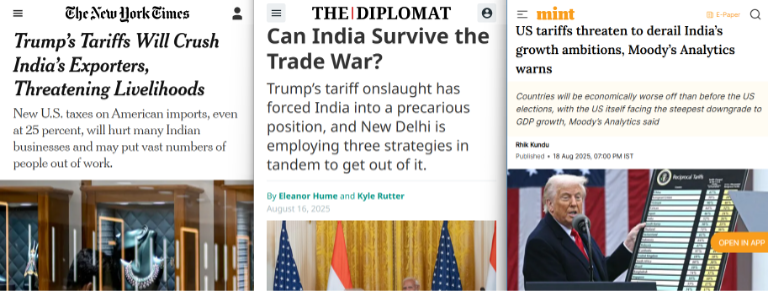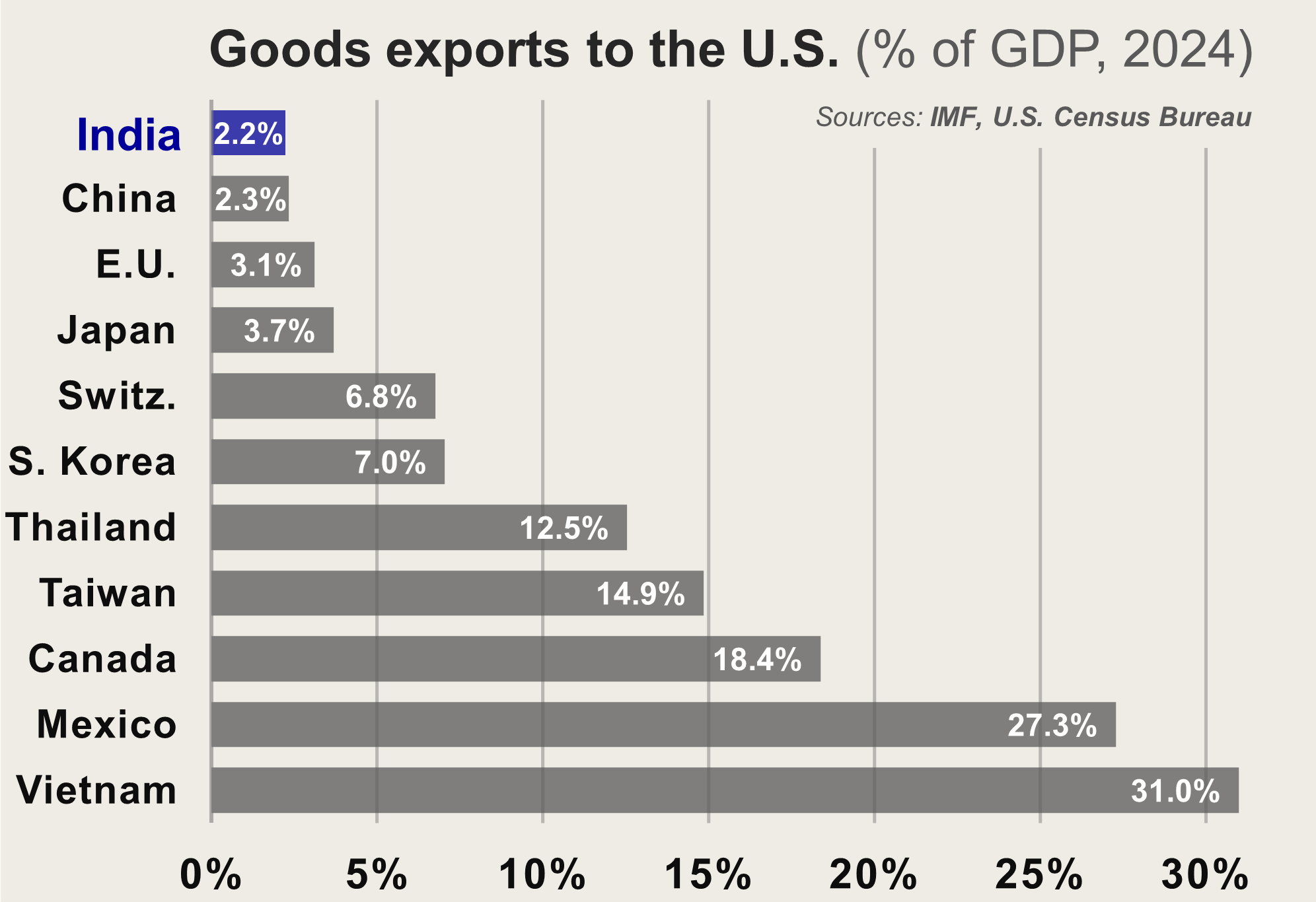Click here to access this dispatch as a formatted PDF.

Trade wars pose little threat to India…
With bombastic headlines such as “Trump’s Tariffs Will Crush India’s Exporters”, “Can India Survive the Trade War?”, and “US tariffs threaten to derail India’s growth ambitions”, news outlets have recently fixated on the supposed threat to India’s growth posed by the Trump administration’s renewed trade war.
Increasing tariffs do imperil export-driven economies such as China, which runs a colossal trade surplus and derives just ~40% of its GDP from private consumption. By contrast, India runs a trade deficit with the rest of the world and has a domestic demand-led economy in which private consumption accounts for ~61% of GDP.
Compared to almost all other emerging markets, India and its companies have limited dependence on trade with the United States. India’s goods exports to the U.S. account for just ~2.2% of the Indian economy – roughly equivalent to the increase in Indian GDP in the most recent quarter, and less than the analogous statistic for other top U.S. trading partners including Canada, China, the European Union, Japan, Mexico, South Korea, Switzerland, Taiwan, Thailand, and Vietnam. Exclude pharmaceuticals and energy (both of which remain tariff-exempt for the time being), and the remaining tariff-impacted exports to the U.S. make up just ~1.7% of India’s GDP. As such, the impact on India of the 25% tariff announced by Donald Trump in late July 2025 should be real but manageable.

As State Street analysts note, “initial signs indicate that Indian tariffs will be significantly less than many of their Asian competitors that are more in the crosshairs of the Trump administration […India] is thus well placed to capitalize on shifting supply chains that result from US protectionist policies and increase their manufacturing exports.”
Estimates of the impact a 25% tariff would have on India’s world-leading GDP growth this year range from 20 basis points to 30 basis points. This does not mean that such a tariff would “shave 20 to 30 percentage points from India’s GDP growth”, as The Economic Times erroneously reported in a recent article. One basis point is one hundredth of 1 percentage point, meaning that 20-30 basis points equates to 0.2%-0.3% – less than 18 days’ worth of economic expansion in an economy boasting a GDP growth rate north of 6.0%.
The additional 25% tariff Trump announced on August 6 would bring the total levy on exports to the U.S. (including his earlier 25% tariff) up to 50%. If this draconian “double tariff” actually comes to pass, we believe the impact would be merely another brief deceleration in GDP growth, followed by reacceleration soon thereafter.
First, because the 21-day delay until it’s supposed to take effect, along with Trump’s track record of repeatedly extending “truces” on threatened tariffs and the fact that China (which buys even more oil from Russia) has not been hit with any such increased levy, all suggest this seemingly aggressive escalation is a tactic aimed at bringing New Delhi back to the negotiating table in the two countries’ recently stalled (but, as of this writing, seemingly continuing) trade talks.
Second, because any abrupt cutoff of the flow of Russian oil to India would risk an immediate spike in global crude and refined products prices. The nearly 2 million barrels/day India currently imports from Russia account for more than one-third of India’s overall crude oil consumption, as well as (via exports of fuel derived from that oil) for a significant chunk of energy consumption abroad (particularly Europe). Attempting to suddenly shift India toward other suppliers would risk adding fuel to the inflationary fire – which would in turn undermine Trump’s very public lobbying for monetary easing by the Fed.
Third, because Trump doubling down on this latest escalation would risk further exacerbating Indians’ growing indignation at being bullied, and thereby (as I recently told Bloomberg News) also put at risk Washington’s until-recently blossoming partnership with a nation whose rapid development and shared apprehension about China means it has been and remains indispensable to U.S. interests, both economically and geopolitically. Just a few months ago, Trump and Modi had publicly pledged to boost bilateral trade to $500 billion by 2030, from $191 billion in 2024.
Fourth, because at ~$87 billion or ~2.2% of GDP, India’s merchandise exports to the U.S. last year were worth significantly more than India’s imports of Russian oil, which in 2024 totaled ~$52 billion or ~1.3% of GDP. India’s actual savings from buying Russian crude at a discount to global benchmark prices last year amounted to a even more minuscule ~$4 billion, or ~0.1% of GDP, with much if not all of that windfall accruing not to consumers but rather to Reliance Industries (India’s largest single importer of Russian oil) and other refiners.
One could imagine a scenario in which Trump and Modi reach some kind of face-saving deal where the flow of Russian energy to India is curtailed indirectly and gradually, say via a major expansion of a Biden-era blacklist of Russia’s “shadow fleet” oil tankers, an expansion of the EU’s price cap on Russian crude exports, and/or a compromise wherein the Modi government would bar the export (but not domestic consumption) of fuel derived from Russian oil. (Given that the EU in any case will soon ban imports of petroleum products derived from Russian crude, that last option would not represent much of a concession on the part of India.)

…and may even be a boon
In contrast to most other large economies, India entered the current trade war with relatively high tariff barriers. Per data covering recent years prior to the current trade war, India’s ~4.6% weighted mean applied tariff (i.e., the average of effectively applied rates weighted by the product import shares corresponding to each partner country) was nearly double the ~2.4% average weighted mean applied tariff among the rest of the world’s top 20 economies. Moreover, weighing by existing product import shares by definition “underweights” sectors where exceptionally high import duties (such as the 70% rate India levies on imported passenger vehicles) limit imports to a miniscule fraction of what they might otherwise be in a lower-tariff alternate universe – as evidenced by India’s substantially higher ~10.1% simple mean applied tariff (i.e., the average of the rates effectively applicable to every product category irrespective of its trade volume).
Mounting barriers to trade with the U.S. might even prove to be a long-term boon if they incentivized India to liberalize trade with other partners via free trade deals such as the one recently sealed with the UK and an even bigger agreement with the European Union that India hopes to finalize by the end of 2025. Any such further reduction in trade barriers would have many benefits, including making Indian exporters more competitive relative to their rivals in countries like Vietnam that currently levy comparatively lower import duties on the raw materials and components needed to produce electronics, pharmaceuticals, and other globally-traded consumer goods.
* * *
Andrei Stetsenko
August 19, 2025
Legal information and disclosures
The views expressed are the views of the author as of the date indicated on each posting; such views are subject to change without notice. Farley Capital L.P. (Farley Capital) has no duty or obligation to update the information contained herein. Further, Farley Capital makes no representation, and it should not be assumed, that past investment performance is an indication of future results. Any discussion regarding investment returns or financial projections are provided as illustrative examples only and no inference shall be made therefrom regarding the potential for returns on any investment discussed. Moreover, you should be aware that all types of investments involve a significant degree of risk, and wherever there is potential for profit, there is also the possibility of loss.
This content is being made available for informational and educational purposes only and should not be used for any other purpose. The information contained herein does not constitute and should not be construed as financial, legal, or tax advice, or as an offering of advisory services. The information contained herein shall not constitute an offer to sell, or a solicitation to subscribe for, interests in any investment vehicle managed by Farley Capital, which offer or solicitation will only be made to qualified investors and accompanied by a private placement memorandum, subscription agreement, and other related offering documents. Certain information contained herein concerning economic trends and performance is based on or derived from information provided by independent third-party sources. Farley Capital believes that the sources from which such information has been obtained are reliable; however, it cannot guarantee the accuracy or completeness of such information and has not independently verified the accuracy or completeness of such information or the assumptions on which such information is based.
This content, including the information contained herein, may not be copied, reproduced, republished, or posted in whole or in part, in any form without the prior written consent of Farley Capital.
References and notes
1 Mishra, Asit Ranjan. Business Standard. “India to remain fastest-growing large economy in FY26, FY27: World Bank” (January 2025). Retrieved from https://www.business-standard.com/economy/news/india-to-remain-fastest-growing-large-economy-in-fy26-fy27-world-bank-125011601478_1.html
2 World Bank. World Development Indicators, “External balance on goods and services (% of GDP)” and “Households and NPISHs final consumption expenditure (% of GDP)” (2025). Retrieved from https://data. worldbank.org/indicator/NE.RSB.GNFS.ZS and https://data.worldbank.org/indicator/NE.CON.PRVT.ZS
3 Guarascio, Francesco. Reuters. “Vietnam’s US exports account for 30% of GDP, making it highly vulnerable to tariffs” (February 2025). Retrieved from https://www.reuters.com/markets/vietnams-us-exports-account-30-gdp-making-it-highly-vulnerable-tariffs-2025-02-25; United States Census Bureau. International Trade Statistics, “U.S. Trade in Goods by Country” (May 2025). Retrieved from https://www.census.gov/foreign-trade/balance
4 Rao, Ganesh. CNBC. “CNBC’s Inside India newsletter: Could India be a hedge against trade wars and tariffs?” (April 2025). Retrieved from https://www.cnbc.com/2025/04/17/could-india-be-a-hedge-against-trade-wars-and-tariffs.html
5 Boak, Josh and Roy, Rajesh. Associated Press. “Trump announces 25% tariff on India and unspecified penalties for buying Russian oil” (July 2025). Retrieved from https://apnews.com/article/trump-tariffs-russia-india-9e388a55583e7007149819c52f0fd71b
6 Siegrist, John and Warburton, Toby. State Street Investment Management. “Reevaluating the India Equity Opportunity” (April 2025). Retrieved from https://www.ssga.com/sg/en/institutional/insights/systematic-active-monthly-april-2025
7 Galani, Una. Reuters. “US-India standoff is about more than Russian oil” (August 2025). Retrieved from https://www.reuters.com/commentary/breakingviews/us-india-standoff-is-about-more-than-russian-oil-2025-08-05; Krishna, Tanya. Financial Express. “India at disadvantage as Trump imposes 25% tariff – Pharma, textiles, auto parts, who’s most at risk? (August 2025). Retrieved from https://www.financialexpress.com/business/industry-india-at-disadvantage-as-trump-imposes-25-tariff-pharma-textiles-auto-parts-whos-most-at-risk-3937223; The Times of India. “Donald Trump tariffs to dent India’s GDP growth? Up to 30 basis points dip possible, say experts; expected trade deal could soften blow” (July 2025). Retrieved from https://timesofindia.indiatimes.com/business/india-business/donald-trump-tariffs-to-dent-indias-gdp-growth-up-to-30-basis-points-dip-possible-say-experts-expected-trade-deal-could-soften-blow/articleshow/123017758.cms
8 ET Online. The Economic Times. “Trump tantrums: Another deadline hangs heavy on India” (August 2025). Retrieved from https://economictimes.indiatimes.com/news/economy/foreign-trade/india-russia-oil-buy-sanctions-threats-donald-trump-tantrums-another-deadline-hangs-heavy-on-india/articleshow/123139364.cms
9 Hawkins, Ari et al. Politico. “US to hike tariffs on India to 50 percent over Russian oil purchases” (August 2025). Retrieved from https://www.politico.com/news/2025/08/06/us-to-hike-tariffs-on-india-to-50-percent-over-russian-oil-purchases-00495411
10 Prusty, Nigam. Reuters. “India pushes ahead with US trade talks despite tariff hike to 50%” (August 2025). Retrieved from https://www.reuters.com/world/india/india-pushes-ahead-with-us-trade-talks-despite-tariff-hike-50-2025-08-11
11 Graham, Emma. CNBC. “Why India is in Trump’s crosshairs when crude is not even sanctioned” (August 2025). Retrieved from https://www.cnbc.com/2025/08/06/why-india-is-in-trumps-crosshairs-when-crude-is-not-even-sanctioned.html
12 Schipani, Andres, Kaushik, Krishn, and Stognei, Anastasia. Financial Times. “India’s Russian oil conundrum: yield to Donald Trump or face tariff backlash” (August 2025). Retrieved from https://www.ft.com/content/f2594187-889e-40ac-97f0-666388eac03a; Reuters. “India's biggest refiner buys US, Middle East crude as Trump slams Russia purchases” (August 2025). Retrieved from https://www.reuters.com/business/energy/indias-biggest-refiner-buys-us-middle-east-crude-trump-slams-russia-purchases-2025-08-04; Verma, Nidhi. Reuters. “India can secure oil even if Russian imports sanctioned, minister says” (July 2025). Retrieved from https://www.reuters.com/business/energy/india-can-secure-oil-even-if-russian-imports-sanctioned-minister-says-2025-07-17
13 Gupta, Swati. Bloomberg News. “Modi’s Rival Blasts ‘Bully’ Trump as Public Opinion Hardens” (August 2025). Retrieved from https://www.bloomberg.com/news/articles/2025-08-06/modi-rival-blasts-bully-trump-as-india-public-opinion-hardens
14 PTI. The Economic Times. “India, US eye $500 billion trade target: Sectoral talks in coming weeks to drive the next big leap” (March 2025). Retrieved from https://economictimes.indiatimes.com/news/economy/foreign-trade/india-us-eye-500-billion-trade-target-sectoral-talks-in-coming-weeks-to-drive-the-next-big-leap/articleshow/119709257.cms
15 Reuters. “Three years into war, US and Europe keep billions in trade with Russia” (August 2025). Retrieved from https://www.reuters.com/world/three-years-into-war-us-and-europe-keep-billions-trade-with-russia-2025-08-05
16 Gupta, Swati and Bhatia, Ruchi. Bloomberg News. “What’s at Stake as Trump Tests India’s Ties With Russia” (August 2025). Retrieved from https://www.bloomberg.com/news/articles/2025-08-07/what-to-know-as-trump-sets-additional-tariffs-for-india-over-its-russia-ties
17 Chin, Yongchang et al. Bloomberg News. “Ambani’s Reliance In Focus Amid EU Sanctions on Russia Oil” (July 2025). Retrieved from https://www.bloomberg.com/news/articles/2025-07-23/ambani-s-reliance-in-focus-as-eu-warns-refiners-using-russia-oil
18 Schipani, Andres, Kaushik, Krishn, and Stognei, Anastasia. Financial Times. “India’s Russian oil conundrum: yield to Donald Trump or face tariff backlash” (August 2025). Retrieved from https://www.ft.com/content/f2594187-889e-40ac-97f0-666388eac03a; Mackinnon, Amy and Cook, Chris. Financial Times. “Donald Trump readiest fresh US sanctions against Russia’s shadow fleet” (August 2025). Retrieved from https://www.ft.com/content/dd50f413-762e-4388-a2a1-fb8b22408447
19 Abnett, Kate, Tunagur, Enes, and Strahm, Milan. Reuters. “What's in the EU's 18th sanctions package against Russia?” (July 2025). Retrieved from https://www.reuters.com/sustainability/boards-policy-regulation/whats-eus-18th-sanctions-package-against-russia-2025-07-18
20 Arunsarv. Wikimedia Commons, “Diwali Urban Shopping, Thiyagaraja Nagar, Chennai”. Retrieved from https://commons.wikimedia.org/wiki/File:Diwali_Urban_Shopping,_Thiyagaraja_Nagar,_Chennai.jpg
21 World Bank. World Development Indicators, “Tariff rate, applied, weighted mean, all products (%)” (July 2025). Retrieved from https://data.worldbank.org/indicator/TM.TAX.MRCH.WM.AR.ZS
22 World Bank. World Development Indicators, “Tariff rate, applied, simple mean, all products (%)” (July 2025). Retrieved from https://data.worldbank.org/indicator/TM.TAX.MRCH.SM.AR.ZS
23 Srivastava, Shruti et al. Bloomberg News. “UK and India Seal Free Trade Agreement Slashing Tariffs, Barriers” (July 2025). Retrieved from https://www.bloomberg.com/news/articles/2025-07-24/uk-india-seal-free-trade-agreement-slashing-tariffs-barriers
24 Khorana, Sangeeta. East Asia Forum. “Racing against time for an EU-India trade deal” (July 2025). Retrieved from https://eastasiaforum.org/2025/07/24/racing-against-time-for-an-eu-india-trade-deal; Kambas, Michele. Reuters. “India expects EU trade deal by year end as Cyprus pledges support” (June 2025). Retrieved from https://www.reuters.com/world/india/india-expects-eu-trade-deal-by-year-end-cyprus-pledges-support-2025-06-16
25 The Economist. “India’s electronics industry is surging” (June 2024). Retrieved from https://www.economist.com/business/2024/06/20/indias-electronics-industry-is-surging
Legal information and disclosures
The views expressed are the views of the author as of the date indicated on each posting; such views are subject to change without notice. Farley Capital L.P. (Farley Capital)has no duty or obligation to update the information contained herein. Further, Farley Capital makes no representation, and it should not be assumed, that past investment performance is an indication of future results. Any discussion regarding investment returns or financial projections are provided as illustrative examples only and no inference shall be made therefrom regarding the potential for returns on any investment discussed. Moreover, you should be aware that all types of investments involve a significant degree of risk, and wherever there is potential for profit, there is also the possibility of loss.
This content is being made available for informational and educational purposes only and should not be used for any other purpose. The information contained herein does not constitute and should not be construed as financial, legal, or tax advice, or as an offering of advisory services. The information contained herein shall not constitute an offer to sell, or a solicitation to subscribe for, interests in any investment vehicle managed by Farley Capital, which offer or solicitation will only be made to qualified investors and accompanied by a private placement memorandum, subscription agreement, and other related offering documents. Certain information contained herein concerning economic trends and performance is based on or derived from information provided by independent third-party sources. Farley Capital believes that the sources from which such information has been obtained are reliable; however, it cannot guarantee the accuracy or completeness of such information and has not independently verified the accuracy or completeness of such information or the assumptions on which such information is based.
This content, including the information contained herein, may not be copied, reproduced, republished, or posted in whole or in part, in any form without the prior written consent of Farley Capital.

